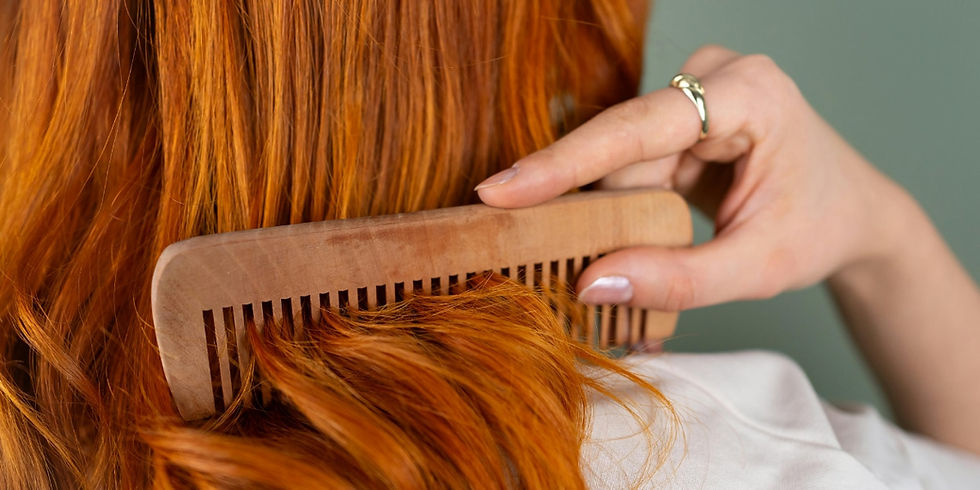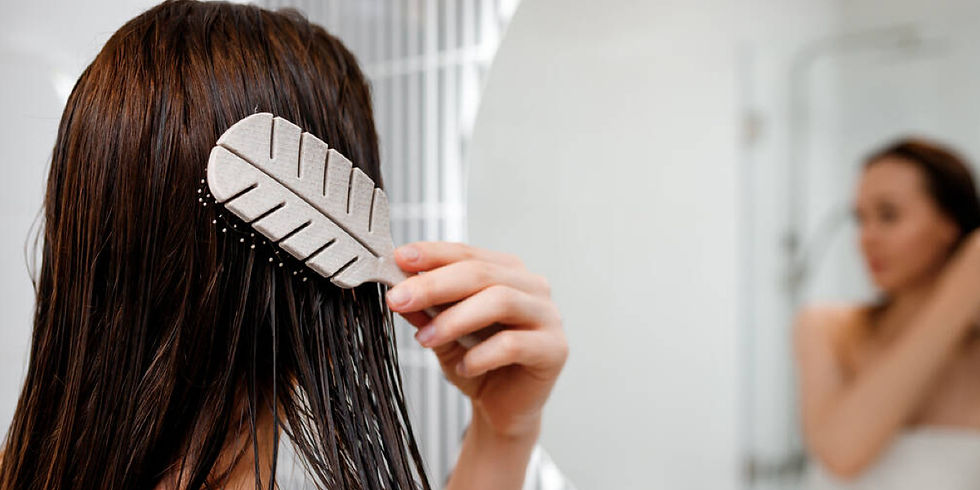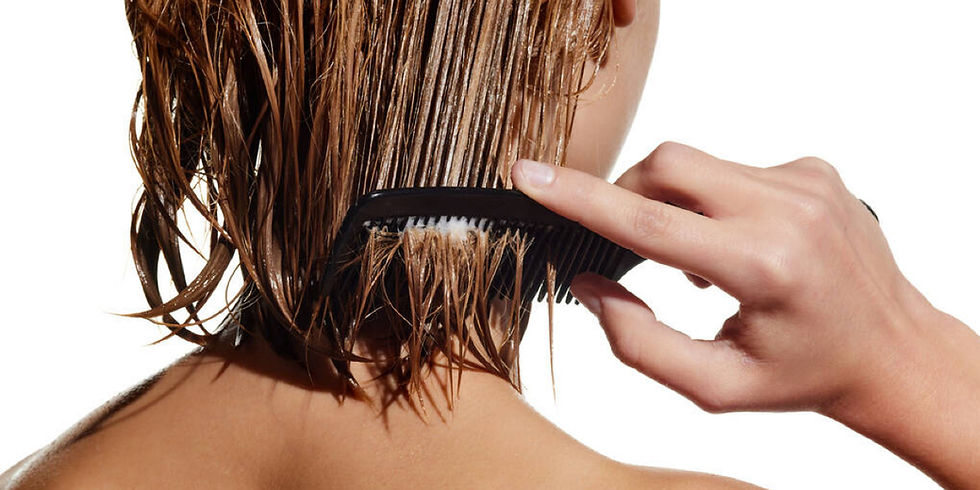Detangling Natural Hair: Tools and Techniques
- Veaudry International
- Jul 1
- 6 min read
Tangles are part of the package when it comes to natural hair. From tight coils to loose curls, the unique shape of each strand makes it easier for them to wrap around each other—and sometimes, themselves. But here’s the good news: detangling doesn’t have to be a painful, frustrating process. With the right tools, techniques, and patience, detangling natural hair can become a soothing and even therapeutic experience.
Today, we’re here to help you find the best hair detangler, choose the right brush for curly hair, and build habits that make detangling a breeze, not a battle. Follow our guide to make it a consistent part of your routine and support healthy, natural hair!
Why Detangling Natural Hair Matters
Natural hair may seem tough, but beneath its textured exterior lies a delicate structure that requires care and attention. Each curl or kink is a potential weak point, which means friction or rough handling can cause significant damage. Besides breakage, untangled hair is prone to dryness, split ends, and scalp issues that can hinder healthy hair growth.
Regular detangling helps you:
Minimise knots and matting.
Distribute natural oils evenly.
Prep your hair for styling.
Reduce shedding buildup.
Support healthy hair growth.
Detangle Hair Brushes and Must-Have Tools
Tangled hair doesn’t need brute force. Instead, it needs the right tools. However, not every brush or comb will work for natural textures, and using the wrong one can cause more harm than good. So, what’s the best hair brush for detangling curly hair and textured locks? Here are some good options:
1. Wide-Tooth Comb
A wide-tooth comb is ideal for detangling natural textures. The wide spacing lets you gently move through knots without dragging strands. It reduces stress on the hair shaft and helps maintain curl definition. For best results, choose one made from smooth, seamless materials like carbon fibre or hard rubber.
2. Hair Detangler
Consider a professional detangling brush like the myDetangler Pro. With flexible dual bristles infused with argan oil, it glides through curls, bending with your texture rather than pulling against it. This makes it especially effective for tighter coils and thicker strands. Its ergonomic design ensures a comfortable grip, while its vented structure improves airflow for faster blow-drying.
3. Spray Bottle (Water or Mix)
Detangling dry hair is a recipe for disaster. Always keep a spray bottle of water (or a water/leave-in mix) nearby to dampen sections before working through tangles. Doing so helps improve elasticity, which is vital when working with textured hair that naturally coils and contracts.
4. Hair Clips or Sectioning Clamps
Trying to detangle your entire hair at once? Don’t. Break it into sections and clip the rest away to stay organised and prevent accidentally tangling parts you’ve already worked through. Use Veaudry myGrip for superior control. It’s a set of high-quality hair clips made from durable materials. They feature a unique design that provides a secure grip.
5. Your Fingers
Before anything else, start with your hands. The tactile advantage of your fingers helps you feel knots and tangles. Gently separate your tangled strands with your fingers before using a comb or brush to prevent additional breakage.

Step-by-Step: How to Detangle Natural Hair
Detangling natural hair takes time, but it’s worth it. Rushing through it can undo all the care you’ve given your hair. So put on your favourite playlist, take it one step at a time, and enjoy the process. Here’s how to do it right:
Step 1: Start Damp, Not Soaked
Begin on damp (not soaking wet) hair. Water helps soften the strands, but drenched hair can be weaker and more prone to snapping.
If you’re detangling post-wash, towel dry with a microfibre towel or t-shirt first.
If you’re starting dry, mist each section with your water/leave-in mix.
Step 2: Section It Out
Divide your hair into sections depending on its thickness and secure each section with clips or bands. The smaller the section, the more control you have. Four sections work for some, while eight or more might be needed for thicker textures. Don’t skip this step—it gives you more control and keeps things organised.
Step 3: Start With Your Fingers
Once your hair is neatly sectioned and secured, it’s time to start the detangling process—but not with your brush just yet. As mentioned, it’s best to gently separate obvious knots and pull apart shed hair with your fingers before using any brush or comb.
Step 4: Apply Your Product
Apply a conditioner, leave-in, or detangling spray generously to one section. Make sure the product is evenly distributed—this is what provides the slip that reduces friction while detangling.
Step 5: Detangle from Ends to Roots
Begin at the ends, where tangles are usually the worst. Take your time and work upward in small, gentle strokes—never yank. If you come across a tough knot, apply a little more product and carefully loosen it with your fingers.
Step 6: Twist or Braid to Keep It Tidy
Once you’ve finished a section, twist or loosely braid it to prevent it from tangling again while you move on. It also gently stretches your curls, making styling a little easier later on.
How to Use a Detangling Brush on Wet Hair
Detangling on wash day can be tricky since wet hair is more fragile. But it’s also one of the best times to remove shed strands and gently work through knots, thanks to all that moisture and slip.
So, how do you detangle wet hair without causing damage? Follow these easy steps:
Never detangle after shampooing alone. Always apply a rich conditioner or deep treatment with lots of slip.
Anchor your roots with one hand while brushing to reduce tension on your scalp.
Use a detangling brush designed for wet hair with flexible bristles or a vented body.
Section your hair and start detangling. Break the section into mini layers, and work your way down with short, light-handed strokes.
If it tugs, stop—don’t force it.
Quickly clear out trapped strands every couple of sections to keep the brush gliding smoothly
Rinse gently, if needed, with cool water to help seal the cuticle and reduce frizz. Let the water flow in one direction to avoid re-tangling

How Often Should You Detangle?
There’s no one-size-fits-all answer—it all depends on your hair type and styling habits. Too much manipulation can cause damage, so skipping daily detangling may be a good idea. Here are some general guidelines to help you figure out what works best for your routine:
If you wear wash-and-go styles: Every 3–4 days to keep tangles from forming.
If you wear protective styles: Detangle thoroughly before styling, then again when taking it down.
If you co-wash or condition regularly: Detangle every time you condition, when your hair is at its most hydrated and slippery.
Hair Detanglers: Best Products for Slip
A little extra slip can go a long way. It’s what lets your fingers or comb glide through without snagging, pulling, or causing breakage. Products with good slip soften the hair, loosen knots, and make the whole process quicker and less stressful, especially for curls, coils, and tight textures.
Here’s what to look for:
Detangling hair spray (general use) — lightweight, works well for fine to medium textures
Detangling spray for curly hair — usually richer, better suited for coils and dense curls
Leave-in conditioners with high slip — perfect right after washing or before styling
Moisture creams or detangling butters — ideal for thick, textured, or high-porosity hair
Keep an eye out for these ingredients:
Marshmallow root
Slippery elm
Aloe vera juice
Coconut oil
Shea butter
Panthenol (pro-vitamin B5)
Common Mistakes That Make Detangling Harder
If detangling feels like a losing battle every time, don’t be too quick to blame your hair type or tools. Even with the best brush and the richest conditioner, certain habits can quietly sabotage your efforts:
Skipping a trim for too long
Layering too many products before detangling
Using elastic hair ties without a seamless cover
Brushing through set styles (like twist-outs or braid-outs) without rehydrating
Detangling hair that has gel dried into it
Upgrade Your Detangling Game with Veaudry
At Veaudry, we’re passionate about transforming hair care into a luxurious, health-conscious experience. Whether you’re on the hunt for the perfect detangling brush, a go-to hairdryer, or a reliable styling iron, we have an extensive range of tools to support your routine. Every product is designed to give you salon-quality results while keeping your hair healthy, strong, and full of life.
Explore our full range and discover tools that make your routine smoother, simpler, and a whole lot more effective!




Comments